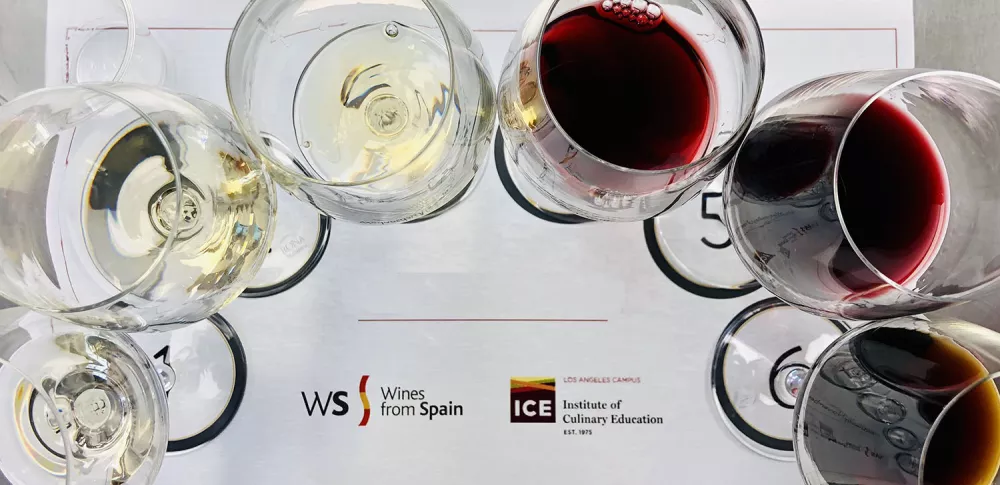As part of Spain Day, a series of seminars featuring Spanish flavors at ICE’s Los Angeles campus, Wines from Spain treated students to a workshop led by Kathleen Thomas, wine training manager at the Hakkasan Group in Las Vegas.

Spain began producing wine more than 3,000 years ago. The earliest examples were vineyards planted in the sherry-producing regions of Jerez and Cadiz, which date back to the Phoenicians around 1100 B.C. Wines from Spain’s Mediterranean coast and the cooler Atlantic coast were traded and consumed by the Romans. Today, the Iberian country is one of the world’s largest producers of wine and the world’s largest exporter in terms of volume. That said, there are many varietals and bottles worth noting. For those new to Spanish viticulture, here are five wines to know, from sparkling to sweet.
Cava
Cava refers to sparkling wines made with the classic method (método tradicional or método clásico) used for Champagne, meaning it must remain on the lees (dead yeast) for a minimum of nine months. All cava must be made from native grape varieties with this traditional secondary fermentation in the bottle.
Recommendation: Students sampled Naveran Brut, a blend of three indigenous grapes: Xarello, which contributes body; Macabeo, which gives aromatic intensity; and Parellada, which lends acidity to the wine. The blend is known for its purity, youth and bright flavors.
- Aromas: ginger, white floral and smoke.
- Flavors: green apple, Meyer lemon and apricot.
- Pairing: “Sparkling wines are the answer to everything!” said Kathleen. “Enjoy at any time, with any food and with good people.”
Albariño
One of the most well-known white wines of Spain, this indigenous variety of Galicia can be rich and expressive or tart and refreshing.
Recommendation: Students sampled the Vionta Limited Release and discovered its good aromatic structure and acidity.
- Aromas: florals, like white and yellow flowers and apple blossoms, bubblegum, agave, beer yeast, saline and earthy granite.
- Flavors: fruity flavors like ripe citrus (oranges and ruby red grapefruit), stone fruit like white peach and nectarine, as well as green apple and melon.
- Pairing: Albariño pairs perfectly with ceviche, fish tacos, seafood pasta and shrimp cocktail.
Verdejo
Crisp and great year-round, it’s a grape that’s often blended with sauvignon blanc.
Recommendation: Bodegas Val de Vid Condesa Eylo Rueda Verdejo comprises 100 percent verdejo grapes from North Central Spain.
- Aromas: white flowers, fennel and Marcona almonds.
- Flavors: citrus elements among notes of lime, grapefruit and Meyer lemon.
- Pairing: Crab cakes, cheese, foie gras, smoked meats, seafood and fish all pair well with this verdejo in addition to salads, rice or pasta dishes.
Tempranillo
The origin of the name tempranillo is derived from the Spanish temprano, or "early," as this red grape in Southern Spain ripens early.
Recommendation: Made according to a traditional Rioja process, Viña Pomal Reserva involves a moderately long maceration time and is decanted after fermentation then clarified slightly before being moved to casks. The wine is aged in semi-new American oak casks for 18 months.
- Aromas: leather, tobacco and clay.
- Flavors: lots of red fruits — cherry, strawberry, red currant — and sour Asian plum notes.
- Pairing: If you’re in the mood to make paella, tempranillo will always be a good companion. Oily fish, vegetable and duck dishes are also surefire pairings for Viña Pomal Reserva.
Sherry
Sherry is a fortified white wine produced in Jerez de la Frontera, El Puerto de Santa Maria and Sanlucar de Barrameda, otherwise known as the “sherry triangle.” Sherry can be sweet or dry and therefore is not limited to consumption after dinner.
Recommendation: Dark mahogany and of great intensity in color, Gonzalez-Byass ‘Nectar’ sherry is velvety with a long and vibrant finish. It should always be served slightly chilled in a white wine glass.
- Aromas: very sweet aromas reminiscent of raisins, figs and dates.
- Flavors: dried nuts, walnuts, chocolate, cinnamon, coffee cake, caramel and toast.
- Pairing: Drink it on its own or pair with less-sweet or even savory desserts.
Look for wine classes at ICE's Los Angeles campus in Spring 2019, and learn more about career programs available now.




